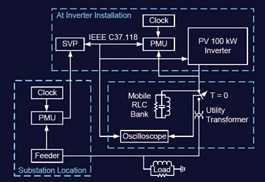Portland General Electric (PGE) is a progressive utility in Portland, Oregon, and its efforts to increase the use of distributed generation (DG) throughout their system put them in a smart grid leadership position. PGE has developed an innovative distributed resources management system called GenOnSys that enables Distributed Generators to be remotely monitored and dispatched for renewable energy tracking, for peaking needs, and for providing operating reserves to the utility power system. PGE also has an aggressive goal: by 2025 it will supply 25 percent of its customers’ electrical energy needs using renewable resources. PGE has already begun expanding their generation in the area of renewables with a 400 MW wind farm and distributed photovoltaic (PV) systems on their customer’s property.
Connecting wind and solar generation into the existing power system has some unique challenges. Specifically, solar generation responds differently than traditional synchronous generators to changing electrical conditions. For instance, solar generation has a very high-speed response (e.g., low inertia) and large power ramp rates due to clouds blocking the sun’s energy, then clouds passing, which, again, sharply ramps up the power. A joint effort between PGE; PV Powered, an Advanced Energy Company; Schweitzer Engineering Laboratories (SEL); and Northern Plains Power Technologies involves developing the next generation of smart inverter technology at two PGE locations: America’s first Solar Highway Project and the Northwest’s largest distributed solar project on ten warehouse rooftops owned by ProLogis.
The U.S. Department of Energy (DOE) sponsored the project to address new grid connection technologies that support integrating solar generated energy. The DOE Solar Energy Technologies Program (SETP) awarded PV Powered a third development grant to fund continued exploration of widespread adoption of solar energy on the grid. DOE’s program, called the Solar Energy Grid Integration System (SEGIS), administered by Sandia Laboratories, focuses on commercialization of the technologies developed in the competitive program. The PV Powered team was awarded the grant after a successful phase 2 witness trial demonstration on the PGE electrical system this past summer.
The SEGIS program, specifically, focuses on making high-density solar generation possible. Using a system approach that utilizes advanced inverters, controllers, and energy management systems, PV Powered, working with PGE, is providing overall project leadership to:
- Improve inverter reliability
- Develop new algorithms to maximize the energy of the inverter and PV system
- Improve solar power forecasting and provide advanced system visibility
- Develop next-generation controls that allow utilities to manage networks of distributed generation
- Design advanced islanding detection and control systems
Better islanding detection and control are particularly pressing needs because the existing approaches for meeting IEEE 1547 requirements were developed based on the assumption that solar distributed generation represented only a small percentage of the total generation capacity. However, PGE has recognized that increasing concentrations of solar generation on power distribution feeders from the utility’s Net Metering, large distributed solar, and feed-in-tariff programs will likely require new approaches to islanding detection and advanced communications with distributed solar inverter systems.
Today, solar generation inverters make autonomous-islanding decisions using local data, such as frequency and voltage, without understanding wide-area power conditions. These approaches make it very difficult for the inverter to distinguish between a local utility outage, which requires anti-islanding, and generalized power sag due to insufficient generation to match peaking loads. This could be aided by keeping the solar-based generators online, and transient disturbances where generators may be required under the Western Electricity Coordinating Council (WECC), to ridethrough the disturbance.
The wide-area information available from time-synchronized phasors, or synchrophasors, provides the measurements needed to improve these methods. For large distributed generators, the standard protection method requires transfer-trip of a substation utility breaker communicated over fiber optics to a breaker at the solar installation. This is expensive, but effective in handling local distribution faults while riding through transmission events where the generation is still needed. However, current inverter technology disconnects the solar power during any power disturbance regardless of its location or cause.
Below is a summary of the SEGIS phase 2 work, done to design advanced islanding detection and control, and the results from the recent witness trial at PGE’s Solar Highway located along the I-5 and I-205 highway corridor.
Islanding Control Methods
When a DG source is islanded from the bulk transmission system, the source must also disconnect from the islanded portion of the electric network. Failure to trip the source could risk personnel safety, power quality, and out-of-phase reclosing. The IEEE 1547 Standard for Interconnecting Distributed Resources With Electric Power Systems defines the requirements for integrating distributed sources into the bulk power grid with an aggregate capacity of 10 MVA or less. IEEE 1547 specifies that a source must disconnect from the islanded system within 2 seconds.
Existing Approaches for Islanding Detection
Commonly used techniques for detecting an islanded condition include perturb and observe approaches, power line carrier communications, and transfer trip schemes. Each of these techniques varies in cost; some are not commercially viable; some systems are very complex; and the power quality delivered to the customer may be unacceptable. Additionally, these techniques may work well with small penetration of PV, but have challenges to overcome in higher penetration scenarios.
The commonly used perturb and observe approach is cost-effective and simple to implement, but has the adverse effect of impacting power quality. The way the perturb and observe approach works is that the inverter actively pushes on a signal component, like frequency. When connected to the grid, this perturbation has little effect. When disconnected from the grid, however, the frequency changes according to the perturbation, and the inverter, upon detection of the excessive frequency change, declares an islanded condition. Issues with this approach include the negative impact it has on power quality. And, as the number of PV inverters increases, frequency shift coupling between them can lead to false islanding detection.
Power line carrier communications (PLCC) is more expensive to implement than the perturb and observe technique, but has no impact on power quality and can be used for high penetration PV installations. PLCC requires expensive equipment to be installed to facilitate sending a “heartbeat” signal across the distribution conductor to the distributed generation sites. This requires that a signal generator be placed in the substation on the secondary side of the feeder and that receivers be placed at each DG site. If the “heartbeat” signal is ever lost, the DG is immediately tripped off. The main disadvantage of this system is its high cost and that there can be interference from other power line carrier communications used. In addition, commercial availability of this approach has not been found by our research team.
Transfer trip is a commonly used technique for interconnecting large DG on a distribution feeder. A transfer trip scheme essentially monitors the status of all of the circuit breakers and reclosers that could island a DG site in a distribution system. When a fault produces a disconnection of the feeder from the substation, a central processor determines the islanded areas and sends a signal to trip the primary breaker associated with the DG system. This scheme is very effective and easy to implement for fixed topologies where the serving substation is located relatively close to the DG system. However, it can get complicated and very expensive if there are several scenarios of feeder reconfiguration or long feeder distances to the solar array.
Using a New Approach for Islanding Detection
Using synchrophasor technology for islanding control has advantages over the existing approaches. Synchrophasors improve these methods as wide-area information is available to each inverter. Using information obtained from a larger area results in better control decisions. Also, the communications paths are simplified because within the wide area only a few select signals need to be monitored. Finally, a system using synchrophasor measurements requires no unnatural forcing of the connected frequency, power, or voltages. Additionally, compressed communications protocols may reduce the need for high-speed communications, such as fiber optics, yet still achieve a fast indication of the islanded condition.
.jpg)
Figure 1: System Layout
System Configuration and Methodology Figure 1 shows the basic system layout. Both bulk power systems and DG locations supply synchrophasor data for the algorithm. The relays in Figure 1 acquire frequency and voltage phasor measurements from their corresponding sites. Relay 1 and Relay 2 send synchrophasor messages at 60 messages per second to the control device, a synchrophasor vector processor (SVP). The SVP receives the synchrophasor data from the relays and calculates the difference between the local and remote synchrophasor measurements to determine if an islanded condition exists.


Figures 2 & 3: PGE Solar Highway site
Witness Evaluation at PGE Solar Highway Site
The islanding control algorithm was tested at PGE on a live feeder powering customer loads. The SEGIS team built a mobile resistive-inductive-capacitive (RLC) resonant load bank capable of islanding the inverter at full output power without disrupting these important loads. Relays that include phasor measurement unit (PMU) functionality were installed at the site location and the governing substation. This allowed the PMU data to be streamed from the substation to the inverter to determine if the PV system was connected to the feeder.
A SEL SVP was installed at the inverter location and performed all anti-islanding control algorithms. Figure 4 shows the system layout. The substation utilized a PMU and a GPS clock. The inverter location also included a PMU and a GPS clock. An oscilloscope provided measurements for the live test. The mobile resonant load bank was a local load that was varied according to the test conditions.
The RLC load bank was tuned to 60 Hz at the representative available output power level of the PV system. During this time, the PV system and tuned RLC load bank were connected directly to the grid. To ensure the system was properly tuned, the grid-side currents were monitored and verified to be zero (real and reactive power from the substation were also zero).

Figure 4: System Connection Diagram
The island was initiated with a contactor, which separated the grid from the PV DG system and RLC load bank, and the island formed. The islanding event was detected by setting the output relay on the local PMU device to write a logical 1 to an oscilloscope when the SVP determined that the slip or acceleration passed the thresholds developed for islanding. This allowed the team to capture the event. Figure 5 shows the islanding event. The yellow trace shows the start of the islanding event. A change of state (in this case, a 5 V signal going to 0 V) occurred when the switch opened the contactor to the grid, and the island was initiated. The green trace is the output of the PMU and is controlled by the SVP to change state when the islanding event is detected. The time required to recognize and respond to the islanding event for this case was 1.12 seconds.
.jpg)
Figure 5: Results from Witness Evaluation Testing
Many islanding events were tested on the system using a quality factor of 1.0, as specified in IEEE 1547. To test the limits of the technique, island tests were performed with a quality factor of 3.0. For each islanded case, the synchrophasor-based technique determined that the distributed PV system was islanded in less than 2 seconds. The 2-second threshold is important because it represents current timing restraints set forth in IEEE 1547 governing safety functions for DG systems.
Tuning the system parameters has produced a much faster response in lab testing, and the team believes that with further refinement of the threshold settings, islanding event detection could be even faster than what was demonstrated at the PGE site. Communication compression or key algorithm reduction may also allow the system to exceed current IEEE 1547 thresholds with lower cost communications, reducing the need for fiber optics.
Synchrophasor measurements provide a viable approach to help solve the problem of highly concentrated PV-based DG islanding detection and control for distribution systems. Stage 3 work will incorporate more wide-area control algorithms into the controller. Future applications could include using the PV inverter to ride through low voltage conditions and other WECC requirements. Similar to the anti-islanding case, providing the PV inverter with time-aligned, wide-area information opens new opportunities to use this information for improved control algorithms. In the future, these improved algorithms will be one of the key innovations to permit safe use of PV systems on all homes and businesses.

Mark Osborn is the Distributed Resources Manager at Portland General Electric. As manager of PGE’s distributed resources department, Mark Osborn oversees the utility’s solar power development, dispatchable standby generation program (DSG), and the net metering and small generator interconnection programs. Osborn also leads PGE’s efforts in the Pacific Northwest Smart Grid Demonstration Project in Salem, Oregon. Under Osborn’s management, PGE has installed three major solar installations in Oregon including the nation’s first solar highway project (104 kilowatt) and two of the Northwest’s largest rooftop installations totaling 3.5 megawatts in northeast Portland. Osborn has more than 30 years energy experience and is an award-winning program manager and successful developer of new products and services for the utility industry.

Bill Flerchinger is a lead engineer in the Distributed Coherent Systems Department at Schweitzer Engineering Laboratories, Inc. (SEL). Prior to joining SEL he worked for Agilent Technologies, Mobile Broadband Division as the Product Planning Manager. He recently completed a Certificate in Transmission and Distribution from Gonzaga University. Bill received his Master’s of Science in Engineering Management and a Bachelor’s of Science in Electrical Engineering from Washington State University.







